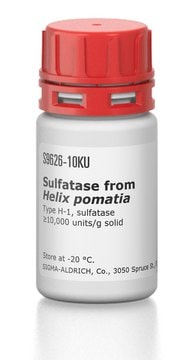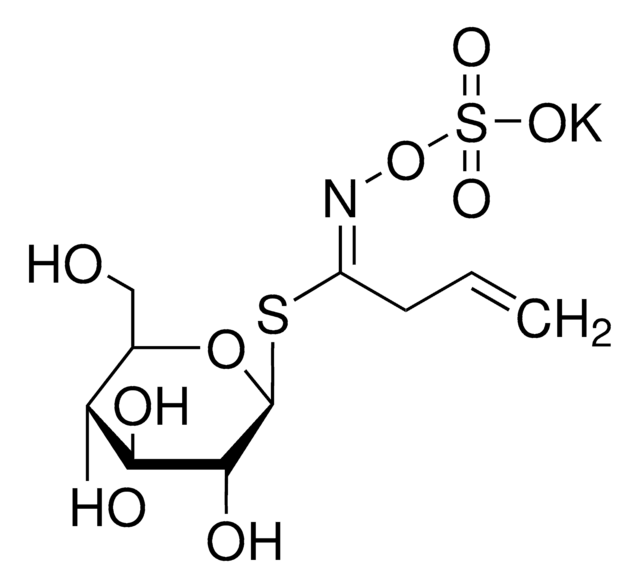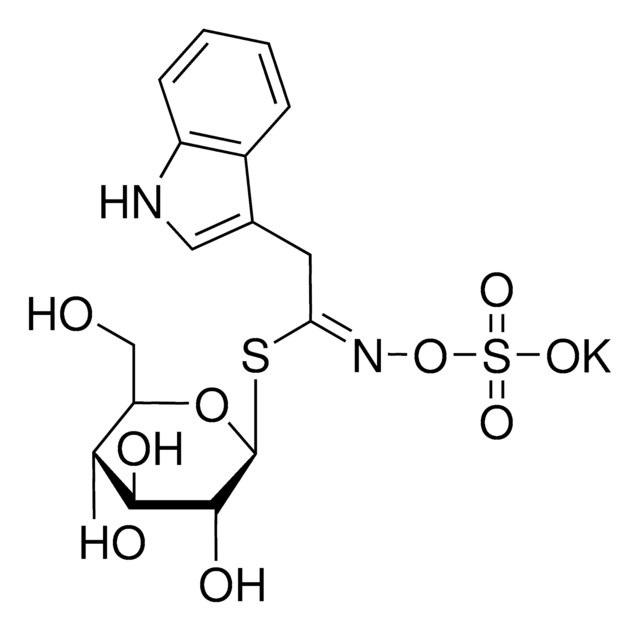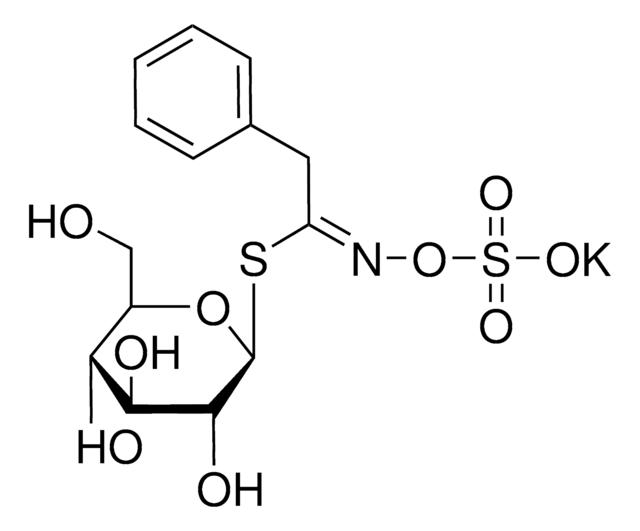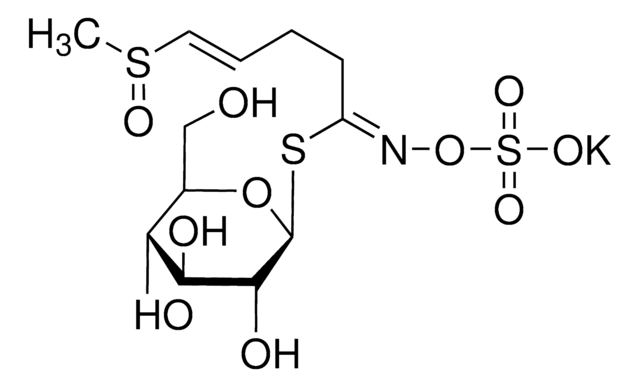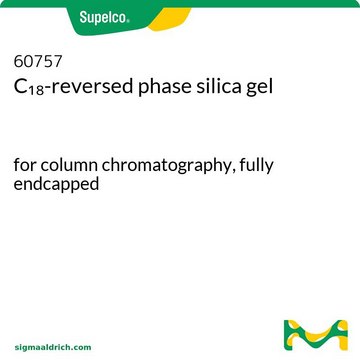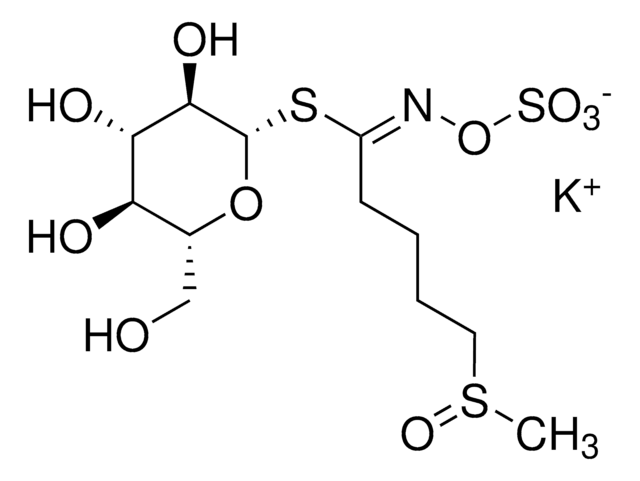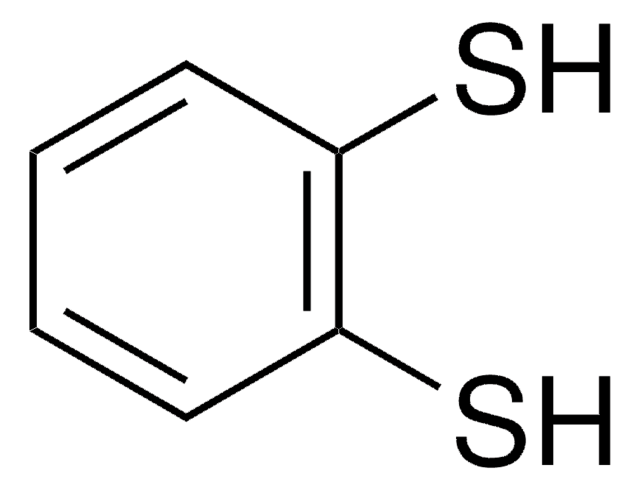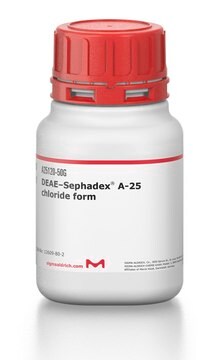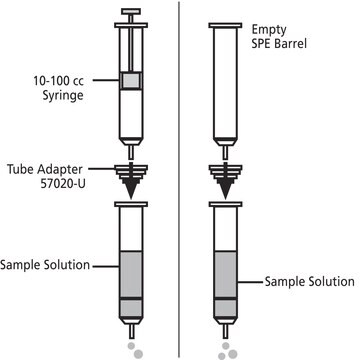추천 제품
생물학적 소스
plant seeds (Sinapis alba)
양식
solid
특이 활성도
≥100 units/g solid
저장 온도
−20°C
일반 설명
Thioglucosidase, also called as myrosinase, is present in the myrosin cells that do not contain glucosinolates. This enzyme is obtained from several plant sources, such as Lepidium sativum, L. Sinapis alba and Brassica napus.
애플리케이션
Thioglucosidase from Sinapis alba (white mustard) seeds has been used as a standard to quantify myrosinase activity and in column glucosinolate analysis of plant samples.
Thioglucosidase has been used in a study to assess Brassica species screening for glucosinolate content. Thioglucosidase has also been used in a study to investigate a negative regulatory role for auxin in sulphate deficiency response in Arabidopsis thaliana.
생화학적/생리학적 작용
Myrosinases are present in many bacteria, fungi, and edible plants, including those of the Brassicaceae (Cruciferae) family. The enzyme hydrolyzes the S-glucosidic bond of a glucosinolate substrate to form an unstable aglycone that rearranges with the loss of sulfate primarily to the isothiocyanate, though thiocyanates and nitriles are also formed. Many of the isothiocyanate products of aliphatic and aromatic glucosinolates have cancer chemopreventive properties.
Thioglucosidase research has focused mainly on the cruciferous crops due to their economic importance and cancer preventive benefits.
단위 정의
One unit will produce 1.0 μmole glucose per min from sinigrin at pH 6.0 at 25 °C.
신호어
Danger
유해 및 위험 성명서
예방조치 성명서
Hazard Classifications
Resp. Sens. 1
Storage Class Code
11 - Combustible Solids
WGK
WGK 3
Flash Point (°F)
Not applicable
Flash Point (°C)
Not applicable
개인 보호 장비
Eyeshields, Gloves, type N95 (US)
이미 열람한 고객
Palatability of Thlaspi caerulescens for snails: influence of zinc and glucosinolates
Noret N, et al.
The New phytologist, 165(3), 763-772 (2005)
Bioavailability of Isothiocyanates From Broccoli Sprouts in Protein, Lipid, and Fiber Gels
Oliviero T, et al.
Molecular Nutrition And Food Research, 62(18), 1700837-1700837 (2018)
Si-Jun Zheng et al.
Journal of chemical ecology, 37(8), 818-829 (2011-06-22)
The jasmonic acid (JA) signaling pathway and defensive secondary metabolites such as glucosinolates are generally considered to play central roles in the defense of brassicaceous plants against herbivorous insects. To determine the function of specific plant genes in plant-insect interactions
Elena Peñas et al.
Journal of agricultural and food chemistry, 59(8), 3772-3779 (2011-03-19)
The influence of two Spanish growing locations with well-differentiated climatic conditions (northern and eastern areas) on the main bioactive compounds, glucosinolates (GLS), total phenolic compounds (TPC), and vitamin C, as well as myrosinase activity and antioxidant capacity in five white
Chemical defence and toxins of plants
Yamane H, et al.
Journal of Hospital Infection (2010)
자사의 과학자팀은 생명 과학, 재료 과학, 화학 합성, 크로마토그래피, 분석 및 기타 많은 영역을 포함한 모든 과학 분야에 경험이 있습니다..
고객지원팀으로 연락바랍니다.
